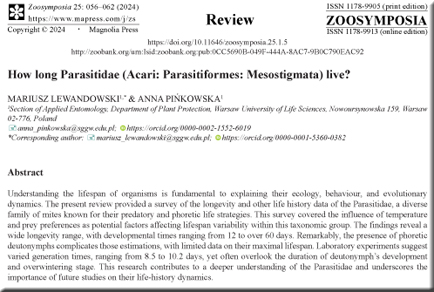Abstract
Understanding the lifespan of organisms is fundamental to explaining their ecology, behaviour, and evolutionary dynamics. The present review provided a survey of the longevity and other life history data of the Parasitidae, a diverse family of mites known for their predatory and phoretic life strategies. This survey covered the influence of temperature and prey preferences as potential factors affecting lifespan variability within this taxonomic group. The findings reveal a wide longevity range, with developmental times ranging from 12 to over 60 days. Remarkably, the presence of phoretic deutonymphs complicates those estimations, with limited data on their maximal lifespan. Laboratory experiments suggest varied generation times, ranging from 8.5 to 10.2 days, yet often overlook the duration of deutonymph’s development and overwintering stage. This research contributes to a deeper understanding of the Parasitidae and underscores the importance of future studies on their life-history dynamics.
References
- Al-Amidi, A.H.K. & Downes, M.J. (1990) Parasitus bituberosus (Acari: Parasitidae), a possible agent for biological control of Heteropeza pygmaea (Diptera: Cecidomyiidae) in mushroom compost. Experimental & Applied Acarology, 8 (1–2), 13–25. https://doi.org/10.1007/BF01193378
- Al-Amidi, A.H.K., Dunne, R. & Downes, M.J. (1991) Parasitus bituberosus (Acari: Parasitidae): An agent for control of Lycoriella solani (Diptera: Sciaridae) in mushroom crops. Experimental & Applied Acarology, 11 (2–3), 159–166. https://doi.org/10.1007/BF01246088
- Beaulieu, F., Dowling, A.P.G., Klompen, H., Moraes, G.J. de & Walter, D.E. (2011) Superorder Parasitiformes Reuter, 1909. In: Zhang, Z-Q. (Ed.), Animal biodiversity: an outline of higher-level classification and survey of taxonomic richness. Zootaxa, 3148, 123–128. https://doi.org/10.11646/zootaxa.3148.1.25
- Costa, M. (1964) Descriptions of the hitherto unknown stages of Parasitus copridis Costa (Acari: Mesostigmata) with notes on its biology. Journal of the Linnean Society of London, Zoology, 45 (305), 209–222. https://doi.org/10.1111/j.1096-3642.1964.tb00496.x
- Costa, M. (1969) The association between mesostigmatic mites and coprid beetles. Acarologia, 11 (3), 411–428.
- De Jong, D., Morse, R.A. & Eickwort, G.C. (1982) Mite Pests Of Honey Bees. Annual Review of Entomology, 27 (1), 229–252. https://doi.org/10.1146/annurev.en.27.010182.001305
- Elbadry, E.A. (1972) Observations on the biology of Pergamasus crassipes (L.), a predaceous gamasid mite inhabiting forest soils in Bavaria (Acarina: Mesostigmata: Parasitidae). Zeitschrift Für Angewandte Entomologie, 71 (1–4), 296–303. https://doi.org/10.1111/j.1439-0418.1972.tb01751.x
- Evans, G.O. (1992) Principles of Acarology. CAB International. https://doi.org/10.1079/9780851988221.0000
- Hartenstein, R. (1962) Life history studies of Pergamasus crassipes and Amblygamasus septentrionalis (Acarina: Parasitidae). Annals of the Entomological Society of America, 55 (2), 196–202. https://doi.org/10.1093/aesa/55.2.196
- Hrúzová, K. & Fenďa, P. (2018) The family Parasitidae (Acari: Mesostigmata) - history, current problems and challenges. Acarologia, 58 (Suppl), 25–42. https://doi.org/10.24349/acarologia/20184280
- Huck, K., Schwarz, H.H. & Schmid-Hempel, P. (1998) Host choice in the phoretic mite Parasitellus fucorum (Mesostigmata: Parasitidae): which bumblebee caste is the best? Oecologia, 115 (3), 385–390. https://doi.org/10.1007/s004420050532
- Hyatt, K.H. (1980) Mites of the subfamily Parasitinae (Mesostigmata: Parasitidae) in the British Isles. Bulletin of the British Museum (Natural History) Zoology, 38, 237–378. https://doi.org/10.5962/p.12620
- Ito, Y. (1973) Effect of isolation on the moult of Parasitus sp.: Deutonymphs (Acarina : Mesostigmata). Applied Entomology and Zoology, 8 (1), 1–7. https://doi.org/10.1303/aez.8.1
- Ito, Y. (1976) Contact Stimulation by crowding for induction of molting in Parasitus gregarius deutonymphs (Acarina: Parasitidae). Applied Entomology and Zoology, 11 (4), 295–301. https://doi.org/10.1303/aez.11.295
- Juvara-Bals, I. (2003) Comments on Leptogamasus trägardh sensu Juvara-Bals, 1981 with the description of Leptogamasus (Holoperigamasus) tabacarui sp. n. (Acari: Gamasida: Parasitidae). Revue Suisse de Zoologie, 110, 797–805. https://doi.org/10.5962/bhl.part.80213
- Koulianos, S. & Schwarz, H.H. (1999) Reproduction, development and diet of Parasitellus fucorum (Mesostigmata: Parasitidae), a mite associated with bumblebees (Hymenoptera: Apidae). Journal of Zoology, 248 (2), 267–269. https://doi.org/10.1111/j.1469-7998.1999.tb01202.x
- Krantz, G.W. & Walter, D.E. (Eds.) (2009) A Manual of Acarology (3. ed). Texas Tech University Press, Lubbock, Texas, 807 pp.
- Müller, J.K. & Schwarz, H.H. (1990) Differences in carrier-preference and evidence of reproductive isolation between mites of Poecilochirus carabi (Acari, Parasitidae) living phoretically on two sympatric Necrophorus species (Coleoptera, Silphidae). Zoologische Jahrbücher, Abteilung Für Systematik, Ökologie Und Geographie Der Tiere, 117 (1), 23–30.
- Rueda‐Ramírez, D., Rios‐Malaver, D., Varela‐Ramírez, A. & Moraes, G.J. (2019) Biology and predation capacity of Parasitus bituberosus (Acari: Mesostigmata: Parasitidae) on Frankliniella occidentalis (Thysanoptera: Thripidae), and free‐living nematodes as its complementary prey. Pest Management Science, 75 (7), 1819–1830. https://doi.org/10.1002/ps.5326
- Schousboe, C. (1987) Deutonymphs of Parasitellus phoretic on Danish bumble bees (Parasitidae, Mesostigmata; Apidae, Hymenoptera). Acarologia, 28, 37–41.
- Schwarz, H.H. & Müller, J.K. (1992) The dispersal behaviour of the phoretic mite Poecilochirus carabi (Mesostigmata, Parasitidae): Adaptation to the breeding biology of its carrier Necrophorus vespilloides (Coleoptera, Silphidae). Oecologia, 89 (4), 487–493. https://doi.org/10.1007/BF00317154
- Schwarz, H.H. & Walzl, M.G. (1996) Pairing, oviposition and development in two sibling species of phoretic mites (Acari: Mesostigmata: Parasitidae: Poecilochirus spp.) associated with burying beetles (Coleoptera: Silphidae: Nicrophorus spp.). Journal of Natural History, 30 (9), 1337–1348. https://doi.org/10.1080/00222939600771251
- Szafranek, P., Lewandowski, M. & Kozak, M. (2013) Prey preference and life tables of the predatory mite Parasitus bituberosus (Acari: Parasitidae) when offered various prey combinations. Experimental and Applied Acarology, 61 (1), 53–67. https://doi.org/10.1007/s10493-013-9701-y
- Szlendak, E. & Lewandowski, M. (2009) Development and reproductive capacity of the predatory mite Parasitus consanguineus (Acari: Parasitidae) reared on the larval stages of Megaselia halterata and Lycoriella ingenua. Experimental and Applied Acarology, 47 (4), 285–292. https://doi.org/10.1007/s10493-008-9218-y
- Witaliński, W. & Podkowa, D. (2016) Sperm structure in Parasitidae mites (Parasitiformes: Mesostigmata: Gamasina). Acarologia, 56 (1), 3–32. https://doi.org/10.1051/acarologia/20162190
- Yasui, Y. (2023) Mite dilemma: Molting to acquire sexual maturity or not molting to ensure durability and dispersal ability in Phorytocarpais fimetorum (Parasitiformes; Gamasida; Parasitidae). Journal of Ethology, 41, 177–184. https://doi.org/10.1007/s10164-023-00783-4
- Yuan, B., He, G. & Dong, W. (2023) The first complete mitochondrial genome of the genus Echinolaelaps reveals mitochondrial genome rearrangement type and evolution of Gamasida. Parasitology, 150 (7), 644–652. https://doi.org/10.1017/S0031182023000367


